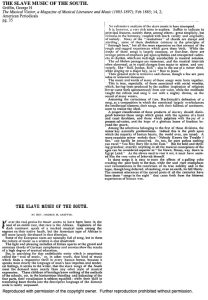When approaching a musical tradition that I find unfamiliar, I hope to analyze that particular tradition with the reverence it deserves. Additionally, I aim to avoid making sweeping statements that describe this music in terms that fit only my personal musical experience.
In today’s entry, I will examine some of the dangers of failing to do these actions within research through Reverend George H. Griffin’s article “The Slave Music of the South,” published in The Musical Visitor, a Magazine of Musical Literature and Music in February of 1885. It is important to note that even though this article is published years after slavery became illegal, the scars of its horrors were still fresh and did not dissipate immediately (if at all).
At first, when I stumbled onto this article, I was taken aback by the glowing praise of slave songs packed into such a short blurb. This author not only labels African American songs as exhibiting the “real genius of music,” but also describes their emotional power on all who experience it. However, after further contemplation, I find his language ultimately misleading and maybe even dangerous.
In this article, Griffin begins with an examination of how the music of enslaved people feels to “outside” listeners. He introduces the concept of the “soul of music” and how this music provokes a “responsive thrill in every human breast.” I find that beginning an article in this manner is interesting. In a lot of musical discourse, authors seem to dive into the sonic descriptions of the music they study before tackling the emotions that these sounds promote. For example, Griffin points to the hauntingly pure melody of “Nobody Knows the Trouble I See.” Ultimately, I think genius for Griffin seems to be primarily how the music makes him feel, not the way it sounds.
The sound of a slave song, however, does contribute to Griffin’s categorization of a “genius” piece of music. Upon his listening, this author points to different aspects of African American song that co-exist with Western Classical ideals. These songs contain balanced and rich harmonies, interesting melodies, abrupt “resolutions,” expressive bass line, common tempo, and “strange points of emphasis put upon syllables and unexpected cadences in rhythm, which are well nigh unreducible to musical notation.” Even though “[n]o exhaustive analysis of slave music is here attempted,” Griffin manages to describe this music in purely western musical terminology (e.g. “harmony,” “resolution,” ad libitum) . The crux of his description is how all “the children of bondage knew nothing of the methods of the school” This music sounds like “genius” to Griffin because these European-esque characteristics appear in enslaved people’s music without a “proper” musical education.
Despite both of these problematic ideas, I found that Griffin’s ending line made my stomach churn the most:
“The sweetest utterance of the sacred poets of all the centuries have been those ‘song in the night’ that came forth from the bitterest experiences of human woe.”
This line may seem bittersweet, because it sounds as though all beautiful creations come from absolute despair — then, “real genius” will manifest. I am somewhat surprised Griffen did not make a reference to ye olde Ludwig Van Beethoven at this moment. Anyway, what I find most troubling about this line is what is the audience supposed to do with this assertion. It seemingly justifies the horrors of slavery with reference to the beautiful music that resulted from the suffering of the enslaved. What are we supposed to do with this conclusion? These questions remind me of Mark Monmonier’s article regarding the way scholarship (in this case, maps) can deceive and justify the unimaginable. Here, Monmonier references the way “Nazi propagandists also used facsimile maps to prove their opponents’ treachery and justify Germany’s advancing western front” (Monmonier 104). I wonder if Griffin is subtly engaging in something similar–with intent, I am not sure.
After sifting through this primary source, I include some questions that came up while writing this post:
- Could an article praising the beauty, emotional power, and “naturally” Western-ness of slave songs justify the actions of those participating in the horrid institution?
- Is this an article to alleviate white guilt?
- Or was the purpose to canonize slave songs within Western Classical Music by pointing out the sonic similarities?
Leave a comment if you have some thoughts!
Footnotes:
Griffin, George H. “THE SLAVE MUSIC OF THE SOUTH.” The Musical Visitor, a Magazine of Musical Literature and Music (1883-1897), 02, 1885. 35, https://www.proquest.com/magazines/slave-music-south/docview/137490866/se-2?accountid=351.
Monmonier, Mark S. How to Lie with Maps Third edition. Chicago, IL: The University of Chicago Press, 2018. https://drive.google.com/file/d/0BxQzWOgr8AurY1lieTR4OUkyRWhvVVpoZDVsTDAwY3JuNlRF/view?resourcekey=0-P–ubpi6ivwKxafR71b9xA
“Nobody Knows the Trouble I’ve Seen.” Streaming Audio. Recorded by Water Garrick. U.S.A. South Negro Folklore Collection. https://search.alexanderstreet.com/view/work/bibliographic_entity%7Crecorded_cd%7C3561996.

